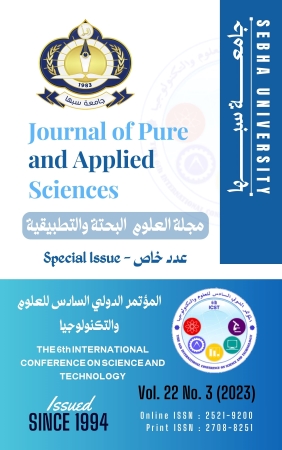Influence of Incorporating PVC Waste on the Mechanical Properties of Cement Mortar
Abstract
Currently, recycling of industrial wastes to reduce the environmental impact is the major concerns of researchers. Polyvinyl chloride (PVC) is one of the waste materials worldwide, with considerable impacts on environmental. Recycling PVC wastes in the concrete or mortar industry is one of the adopted ways to decrease such impact. The purpose of this paper is the reuse of PVC waste deriving from the workshops manufactured doors and windows which made of PVC material. The waste of polyvinyl chloride was collected from one of the factories located in AL-Khoms, then the waste was sieved, the sample that passed through Sieve No.4 and retained on sieve No.10 was taken. The PVC waste proportions of (0.06 ˛ 0.08 ˛ 0.1) by weight of cement was added to the mix mortar. The tests carried out during this study were; air content of fresh cement mortar, flow table, dry density of hardened cement mortar, flexural and compression, free shrinkage and finally ultrasound pulse velocity. The results obtained showed a significant improvement in the sound insulation and a decrease in the dry density of the mortar. While the compressive and flexural strength results were slightly lower compared to the standard mortar. In addition, a decrease in the values of flow, free shrinkage and air content was observed with an increase in the PVC content. Nevertheless, the mortar obtained contributes to the conservation of natural resources and maintains the mechanical properties of the cement mortar in structural applications.
Full text article
Authors
Copyright (c) 2023 Journal of Pure & Applied Sciences

This work is licensed under a Creative Commons Attribution 4.0 International License.
In a brief statement, the rights relate to the publication and distribution of research published in the journal of the University of Sebha where authors who have published their articles in the journal of the university of Sebha should how they can use or distribute their articles. They reserve all their rights to the published works, such as (but not limited to) the following rights:
- Copyright and other property rights related to the article, such as patent rights.
- Research published in the journal of the University of Sebha and used in its future works, including lectures and books, the right to reproduce articles for their own purposes, and the right to self-archive their articles.
- The right to enter a separate article, or for a non-exclusive distribution of their article with an acknowledgment of its initial publication in the journal of Sebha University.
Privacy Statement The names and e-mail addresses entered on the Sabha University Journal site will be used for the aforementioned purposes only and for which they were used.

